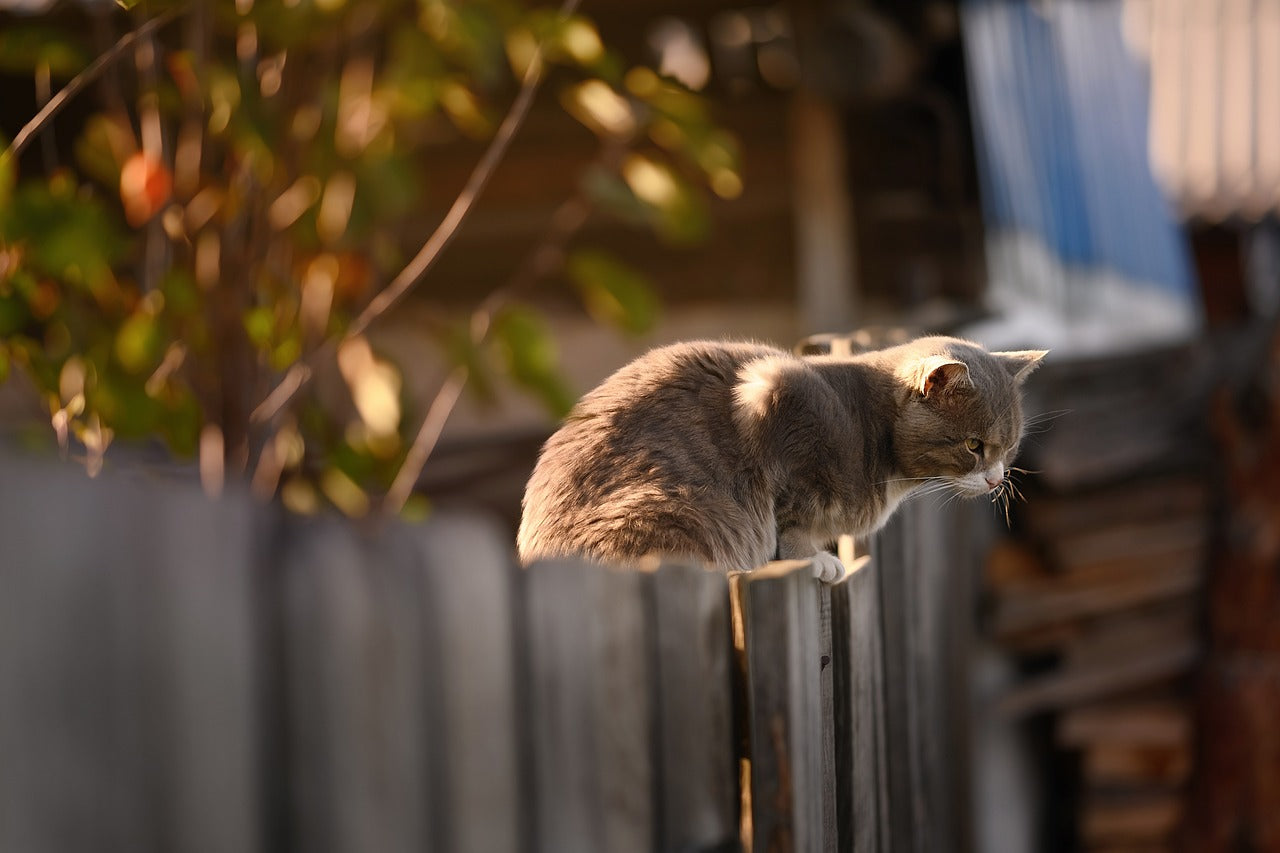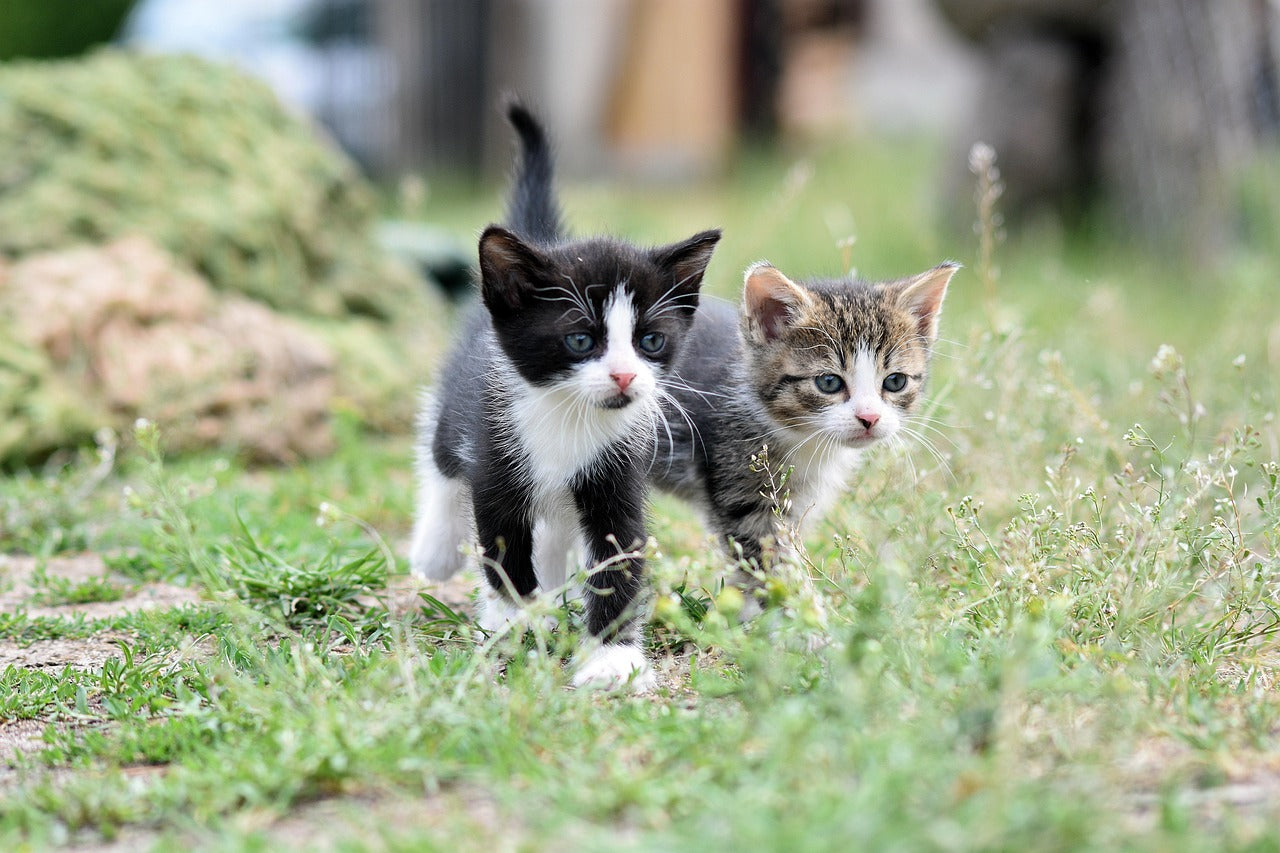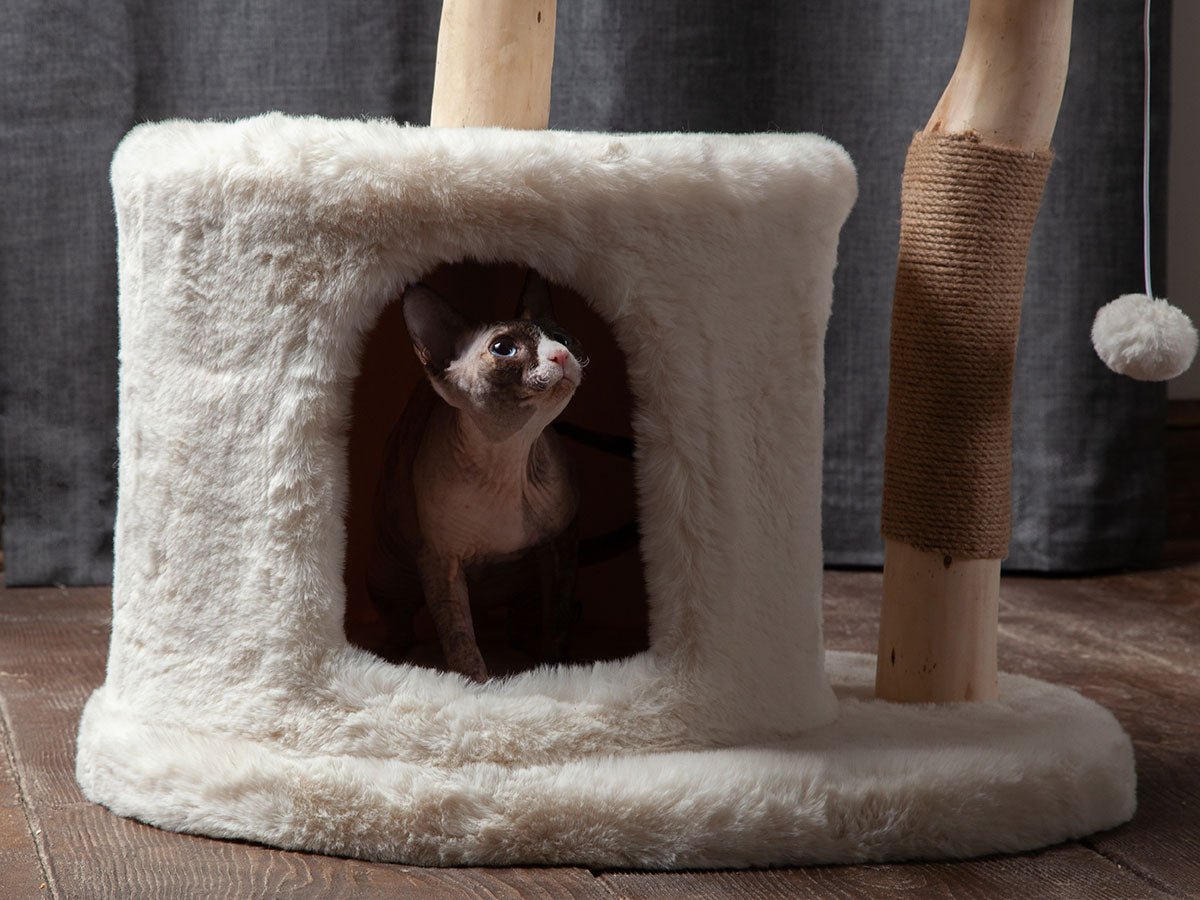So, what is a catio exactly? Simply put, a catio is a cat patio! Or maybe it’s a patio for cats, or it could be a cat run, or a place where cats can run… Whichever way you prefer to think of it, a catio is an outdoor cat enclosure, oftentimes located on a patio (but not necessarily!), that offers cats a safe space to explore outside. They come in all different shapes, sizes, materials, and configurations. Catios can even include fun features like perches, hammocks, ramps, tunnels, stairs, and bridges for added interest. Afterall, the whole point is to make it fun for your cat(s) (and for you to enjoy watching them!)
A quick online search for catios will produce an overwhelming amount of catio options, from buying a pre-built enclosure to instructions and videos for making your own DIY catio. Choosing which direction you go on your catio adventure will likely depend on a combination of things such as budget, durability, aesthetics, ease of installation, and how handy you consider yourself when it comes to DIY projects. Planning and researching can often be the most tedious part of purchasing a catio. So much so that some of the more premium catio builders even include complementary planning services. For example, at Habitat Haven we have a team of planning engineers able to help you remotely to engineer, plan, and provide installation advice all before your catio even arrives.

Should Cats be Outside?
Before you jump into planning your outdoor cat enclosure, it may first be helpful to determine if a catio is right for you and your cats. According to Kelley Bollen, a renowned expert in animal welfare,she asserts that access to the outdoors is crucial for cats. However, there may be several reasons that you’d prefer to keep your feline friend indoors. After all, there are dangers outdoors such as predators, unfriendly neighbors, busy roads and more. But, experts agree that cats are very similar to dogs in that their lives are enriched by the sights, smells, and textures of the outdoors. There are countless examples of bad kitty behavior being resolved simply by giving cats outdoor access.

While outdoors, cats are able to express many of their natural, instinctual behaviors like climbing trees and using their keen senses of smell and hearing to explore their surroundings. However, allowing cats to roam freely outdoors can be quite dangerous. In fact, the experts at Animal Humane Society in Minnesota estimate that cats who are allowed to roam freely outdoors may have a lifespan that is 10-12 years shorter than the average indoor cat.
Free roaming cats also pose a threat to the local wildlife. In arecent study that tracked the movements of 925 house cats, researchers at NC State University and scientists at the North Carolina Museum of Natural Sciences discovered that house cats have a two- to 10-times larger impact on local wildlife than wild predators. This study did not track stray or feral cats, so it’s possible that the impact may be even greater! Cats hunt for birds, mice, squirrels, and reptiles while outside, and since they generally stick to a relatively small area, they can have a large impact on the local ecosystem.

Many cats that live exclusively indoors also find themselves bored and lacking the mental stimulation that can deter unwanted behaviors such as urinating in the house, using the furniture as their own personal scratching posts, and fighting with pet siblings. Access to the outdoors can certainly help alleviate many of these issues as it allows them to express themselves more naturally outside of the home so that they can rest easier indoors.
Outdoor catios are a great option that offer the “best of both worlds” by allowing your cat to safely access the outdoors, and by providing an enriching environment for them to explore, all while keeping them safely contained “inside.” In addition, it canhelp them lead healthier lives according to the same study mentioned above. A catio keeps your cat out of harm's way of many pests, parasites, and diseases. It gives them the outdoor access they need to reduce stress and express their natural instincts. And it can even provide them with the added benefit of exercise - especially within a catio that includes several shelves, perches, or stairs for them to climb.
Catio Building Materials
If you have decided that a catio is the best option for you, the first things to consider when searching for the right catio are the materials and durability. Catios can range in price from a few hundred dollars to a few thousand dollars (and sometimes even more!), but no matter how big or small your budget is, you likely want longevity out of your investment. Longevity typically begins with the type and quality of materials used. Pre-built catios and DIY catios both can be made from many different materials, but most commonly they feature a wood or metal structure with a wire mesh or screen covering that allows your cat to enjoy the outdoors safely all year long.
It’s best to look for catios that are built with non-toxic materials since your cat will surely be spending a lot of time inside! Look for materials such as untreated lumber or cedar and lead-free or low lead metals.
Lumber

Wood, for example, can be a great, easy-to-find material, but if you live in a particularly wet climate the moisture may cause it to deteriorate more quickly over time than some other materials. Wood can be treated, stained, or painted to increase its length of life - but be sure you are not using anything that may be potentially toxic to cats! Wood will also require regular maintenance to keep it in tip-top shape, and will likely need to be replaced eventually.
An alternative to untreated lumber may be natural cedar. Cedar lumber is naturally water resistant which makes it more durable against rot than other types of wood. Because of this, cedar is often used in outdoor building projects. It even repels insects! This bonus feature is especially great for outdoor catios as the natural cedar will help repel fleas, ticks, and other insects that may be detrimental to your cat.
Metal

When it comes to metal, there are many options! Aluminum tends to be a more lightweight option, but it is quite a bit softer, and often more costly than other metals. This means that it can be more prone to dents and damage. Steel is generally a more durable and heavy-duty metal. However, it is available in several finishes: untreated or unfinished, galvanized, and powder coated to name a few.
Untreated or unfinished steel is exactly as it sounds - steel that has not been treated with anything to slow or stop rust and corrosion. This is not a great choice for an outdoor catio.
Galvanized steel has been treated for outdoor use. It has been coated in a zinc material for added durability against corrosion in outdoor environments. For this reason, it tends to be an economical choice for building a catio. However, the coating will break down over time and eventually the untreated steel underneath will become exposed and vulnerable to corrosion.
Powder coated steel will offer the most durable building material (bonus points if it is galvanized before powder coating since that provides a “belt and suspenders” type protection!). Powder coating is a process that adds a high-quality, long-lasting finish to the metal. This finish is highly durable and resistant to scratching, chipping, and weathering. It is often used on commercial machinery due to its durability.
Mesh or Screen Covering

When it comes to the wire mesh or screen covering, not only will the type of material be important, but you may even want to think about the size of the openings. Generally speaking, wire mesh will be more long-lasting than most other screen material as screens may not withstand sharp kitty claws, although there are some options out there for pet-safe screens that may fare better. Commonly, lower quality "chicken wire" is used which can work in the short term but degrades quickly and also fails to stand up to larger predators.
In addition to ensuring the mesh is rugged, the openings must be appropriate as well. If the openings are too small, then the catio may not feel as open and ‘outdoorsy’. Too large and your cats may find a way to squeeze through! Openings that are no more than 2” x 2” are ideal for the majority of cats.
Perhaps even the overall look and aesthetic of the catio is important to you. Sometimes a wooden or metal frame can leave a catio feeling bulky and obstruct the view through the enclosure. This aspect is near and dear to our hearts, since Habitat Haven catio designs do not rely on bulky frames, and provide a unique “frameless” design to provide the most space and the least obstructed views.
Installation and Assembly
What you can expect for installation and assembly will vary depending on which outdoor catio option you select. Generally speaking, smaller lower cost pre-built cat enclosures include fewer components and offer a quick and easy set up and installation. Larger premium outdoor cat enclosures tend to have more intricate designs that lend themselves to a more involved installation and assembly process. And if you choose to build a DIY catio, then every aspect of the installation and assembly process is in your hands!

One added benefit to creating a DIY cat enclosure is that you can make “on the fly” adjustments throughout the installation. While most pre-built options make it difficult to make on-site adjustments, others are more customizable. Take the enclosures at Habitat Haven, for example, which can be modified relatively easily to work around some obstacles like door and window frames, light fixtures, and even tree limbs!
How to Choose the Best Catio for You and Your Cat
Location
Whether you’re looking for a catio for 1 cat or 10 (or more!) there is a solution out there for you and your feline family members. With all of the options available, you may be wondering exactly where to start or how to choose the right catio for you and your cats.
The best place to start is with the location of the catio. Is there a particular space you have in mind? Or maybe you have several possible locations in mind! A catio can be a great focal point or it can be tucked away to blend in with the surroundings. Cats enjoy being up high, so tunnels or enclosures up high (or even in a tree!) offer the perfect location to perch and watch activity below.
You can even work the catio into your existing landscaping so that it’s more out of sight. This can allow your cat to feel like they are out in the wild prowling through the trees and plants, which provides the mental stimulation that they need to help curb boredom and keep them active.
Access
When it comes to location, you also want to think about how your cat will access the catio, so if you have several location possibilities in mind, you may be able to narrow it down by thinking about how your cat will get into and out of the catio.
There are a handful of options:
- Pet Door - This is the most common way that cat owners give their cats access to a catio, as it is probably the most versatile option. Pet doors can be placed in a wall, window, screen, or door which allows you to create an access point just about anywhere!

- Window - You can even choose to enclose an entire window and skip the pet door altogether. A window without a screen can be simply opened to allow your cats to enter the catio, and closed to prevent them from going outside as needed.
- Door - If you have the space, and you plan to hang out in the catio with your cat, then you may even choose to enclose an entire door!
Size of Enclosure
After you have determined the best location and point of entry, the next thing to take into account is size. Catios can be built practically any size to suit your needs. From wide open and spacious to small and compact, you have several options when it comes to the size of your catio! You may even choose to create a sprawling, multi-unit catio that offers a variety of spaces, high and low, for your cats to investigate.
The overall size of your enclosure should also take into account the number of cats that will be spending time inside. The overarching theme here tends to be that more cats means more space is required, however, it may not always be so straightforward. There are a lot of factors to consider when choosing your enclosure size from budget to the amount of space you have to work with. Our expertise has led us to understand that some space is always better than none!
A well designed cat enclosure will make the best use of the space inside, allowing cats to take advantage of the square footage as well as the vertical space. It is typically recommended that you allow for approximately 20-30 cubic feet of space per cat. (In case your math skills are a little rusty, you can use this handy tool. But, again, some space is always better than none - the cats are certainly just happy to get some fresh air!

Keep in mind that this recommendation also applies generally to cats that get along well with one another. For cats who are not so fond of each other, more space may be needed. For several large cats like Maine Coons or Ragdolls, you may also consider giving them more space.
Catio Layout and Configuration
Large outdoor cat enclosures can be spacious and will create a wide open area in the middle of the catio. This can be especially great if you plan to hang out in the enclosure with your cats, or if you have plans to add fun, large features for your cats to climb and scratch. The main drawback to large, open catios is that they may not allow your cat to have an interesting space to explore. If there is a large, wide open space in the center, then it is easy for your cat to simply walk from one side to the other instead of using shelving, steps, or perches to navigate around the catio.
Which brings us to the next option - a sprawling, multi-unit catio that creates an enriching environment for your cats to explore. Multi-unit catios typically include 2 or 3 smaller enclosures of varying sizes that are connected with interesting components such as tunnels or stairs. They may offer several different areas for your cat to perch or lounge, and give them multiple vantage points for watching wildlife both in the air and on the ground. For households with multiple cats this can be a great option as well as it can provide separate spaces for your cats to spend some time away from one another.
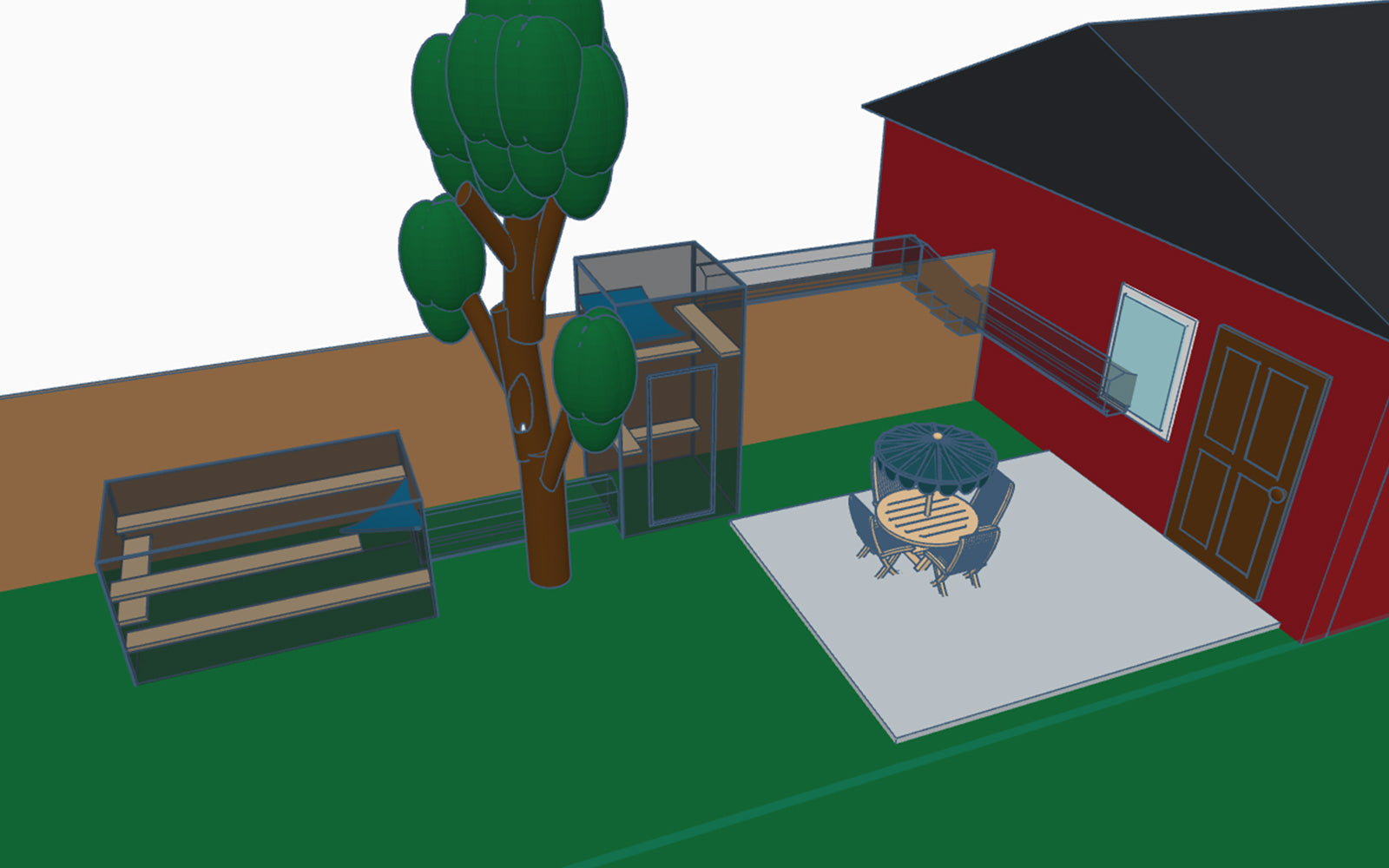
But what if you are constrained to a more compact space? There are solutions for tight areas too! If you are working in a very limited area, a window catio offers a great solution with a small footprint. Most window catio enclosures are designed to fit over just about any window and secure to the side of the house or building. They can offer a simple solution to give your cat some fresh air, a hammock in the sun, and maybe even a place up high to perch and watch the birds.
If you have a little bit more room, go for a small catio that makes the most out of the space. Cats love to get up high, so try to go vertical and keep your overall footprint small. Shelves, steps, and hammocks can be added so your cat can maneuver up and down the enclosure.
Types of Catios and Accessories
Since you are now certainly aware of window enclosures, you may be curious as to what other types of catios are available, and when you may decide to choose one over the others. Some options, or even DIY catio plans, will give you the option between a 3-Sided catio (open on one side to go against a wall) and a 4-Sided enclosure (fully enclosed to sit freestanding). But when does one make more sense than the other?
If your access point is a door or window, you may opt for the 3-Sided option. A 3-Sided catio can be made to specific dimensions to encompass the entire door or window. Anytime the catio will be assembled or installed flush against a house or building, you may consider a 3-Sided enclosure. The open side can be secured directly to the surface of the wall for some added structural stability.

4-Sided enclosures make great standalone enclosures if you plan to place the catio away from a house or building. This also allows you to incorporate other fun components like tunnels to get your cat from the access point into the enclosure.
When building a multi-unit catio, you could use either 3-Sided, 4-Sided, or a combination of both enclosures depending on your overall vision. In order to connect them all together, you can use tunnels, stairs, or bridges. These can be placed both high and low to give your cats a variety of vantage points.
Tunnels tend to be the most versatile and most popular component, however, stairs and bridges (which essentially combine stairs and tunnels) allow your cat to ascend or descend as needed, or even go up and over obstacles like tree branches.
Another component that can be utilized is what we call a tower. A tower is kind of like a mini 3-sided enclosure that can be secured over your access point or against any surface. This is most helpful when the access point is difficult to connect to. Perhaps it is too high, or there is something in the way in between the access point and the main catio enclosure; a tower in combination with a tunnel could be used to work around the obstacles.

Towers can also be used in place of stairs for catios that are installed against a wall. In more compact spaces, towers can allow you to quickly achieve additional height!
Catio Accessories
So now you have the catio designed - but what can you add inside to make it interesting and enriching?
Shelving is an easy to add accessory that will allow your cats to get vertical and give them something to climb. Shelves can even be made wide enough for your cats to lie down on.
Perches and cat trees allow cats to get up high and watch the world below. They can even be used as a staircase to bring cats down from a window or a high perch!
Hammocks are also available and they offer inviting areas to lounge, sunbathe, and nap. If you have multiple cats, you might even find them piled up together inside a hammock.
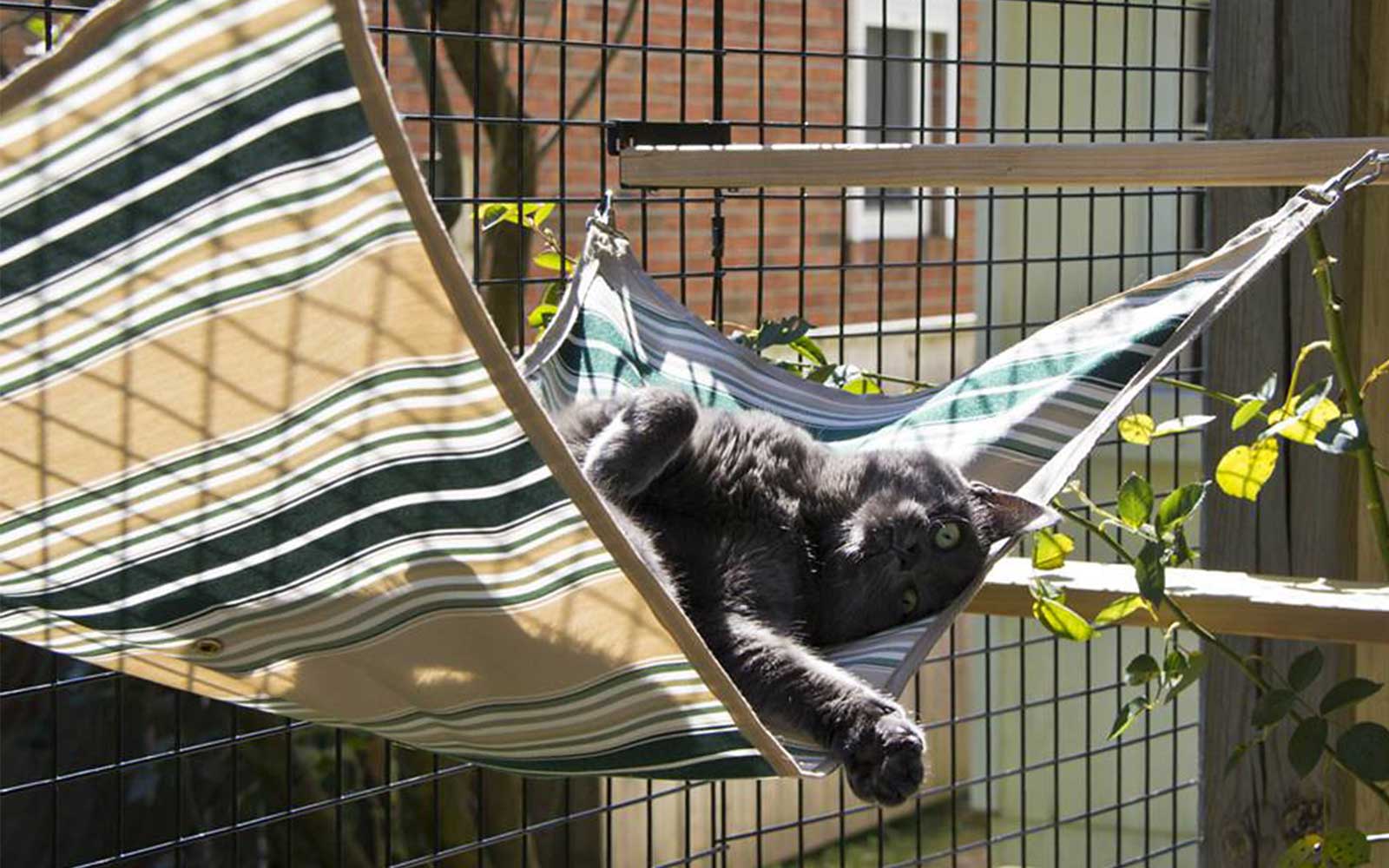
Awnings are available to provide shade in hot, sunny locations, or cover and offer protection from rain so that cats can still enjoy the outdoors on a rainy day.
Many people also add things like scratching posts, tree limbs, and plants (cat safe, of course!) inside. If the catio is large enough, you may even have room for a chair so you can hangout too!
Put it All Together
 Catios comes in all sizes, materials, configurations, and an array of options. They can easily provide your cat with a safe, enriching environment that provides the mental stimulation they require to lead happy, healthy lives.
Catios comes in all sizes, materials, configurations, and an array of options. They can easily provide your cat with a safe, enriching environment that provides the mental stimulation they require to lead happy, healthy lives.
We hope that you now have a more informed knowledge on catio options. This intent is to give you confidence to start your planning and begin the rewarding process of creating outdoor space for your cats.
Many cat parents will find the best next step is to make a drawing and put your ideas down on paper. This will help you visualize your ideas and allow you to more easily explain to potential catio builders, friends, and family what you hope to accomplish! At Habitat Haven, we love to see drawings similar to what is shown above.
Did you know? The term ‘Catio’ was first coined in a New York Times article about Habitat Haven enclosures in 2003. That is why Habitat Haven is known as the "original catio!" Let the most experienced catio experts help you design your catio!


